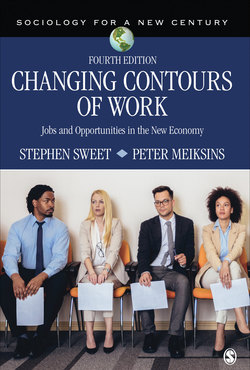Читать книгу Changing Contours of Work - Stephen Sweet - Страница 26
На сайте Литреса книга снята с продажи.
Chapter 2 New Products, New Ways of Working, and the New Economy
ОглавлениеOne of the most popular themes in discussions of work is the idea that recent changes in work constitute the equivalent of a second industrial revolution. Consider, for example, the impact computers have had on the ways jobs are performed and designed. Computers enable workers to correspond at great distances, telecommute from home, and access a wide array of information. These “smart machines” have absorbed many workers’ jobs and replaced human hands with robotic pincers that move with exacting precision. Computers also have spawned new markets for software and hardware, creating new jobs requiring new skills. Their reach spans the world, enabling near-instantaneous transmission of information, as well as the coordination of complex trade relationships that link companies with one another in global webs. It is hard not to conclude that computers have sparked revolutionary changes—not only in what is being produced and how jobs are designed, but also in the geographic distribution of work. What impact do these types of changes have on current and future generations of workers?
The use of the concept of a “new economy” (or alternate terms such as global economy) is widely accepted as a shorthand way of saying that work today is remarkably different than it was in the recent past. But in this chapter, we open this assumption to debate. If there is a new economy, what are its distinguishing characteristics? We argue that jobs have changed in profound ways. There are new technologies, organizational designs, industries, and markets. The economy has become increasingly international. These changes have introduced the need to develop new skills to fit changing opportunity structures. But what is equally true is that many aspects of the “old economy,” including the design of jobs to require limited skill, have either survived or been reproduced in new forms. After all, for every successful computer programmer who works at a company like Microsoft, one can find three poorly paid workers laboring on hamburger assembly lines at companies like McDonald’s.1 Understanding the new, the old, and the old in the new is the key to understanding the diverse needs and experiences of today’s workforce.
In this chapter, we consider some of the major changes said to characterize work in the new economy, including the decline of mass production and manufacturing work, new skill requirements, the impact of new technologies, the emergence of new cultures of control, the gradual decline of organized labor, the rise of flexible work arrangements, and globalization. In each case, we argue that there have been significant changes but also that there are persistent features that reflect the perpetuation of the old economy within the new.
